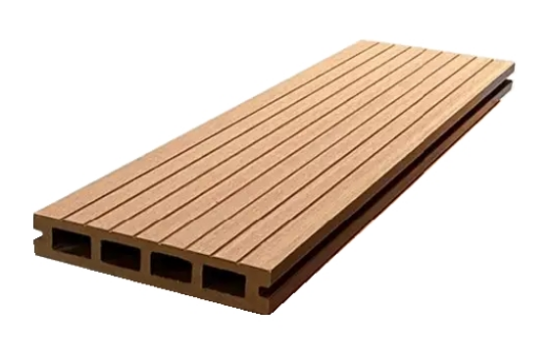Three Main Types Of Bamboo Decking
Composite bamboo decking, solid bamboo decking, and strand woven bamboo decking are three popular types of bamboo decking materials. Each type has its unique advantages and disadvantages, and it is essential to understand these before making a decision. In this article, we will explore the pros and cons of each type of bamboo decking, helping you make an informed decision for your outdoor space.
1. Composite Bamboo Decking

Composite bamboo decking, also known as bamboo-plastic composite decking, is a type of decking material that is created by combining bamboo powder, recycled plastics, and other additives and coloring agents. This results in a material that is not only cost-effective, but also easy to maintain and has a low level of required maintenance.

Advantages of composite bamboo decking
Resistance to Rot & Decay
Low-Maintenance

- Resistance to Rot & Decay
One of the primary benefits of composite bamboo decking is its resistance to rot and decay. This feature is due to the combination of materials used in the production process, which makes it an ideal choice for outdoor areas and high traffic environments.
- Low-Maintenance
Another advantage of composite bamboo decking is its ease of maintenance. Unlike traditional wood decking, it does not require staining or sealing and can be cleaned with soap and water, making it a hassle-free option for those who prefer low-maintenance decking.

Disadvantages of composite bamboo decking
Not Ideal for Areas with Harsh Weather Conditions
Limitations of Composite Bamboo Decking’s Appearance
Not Be As Green As You Think
Lack of Strength

- Limitations of Composite Bamboo Decking’s Appearance
While advancements have been made to improve the appearance of composite bamboo decking and make it more similar to outdoor strand woven bamboo decking, the plastic material used may become more apparent over time, resulting in a less natural and high-end appearance. Additionally, composite bamboo decking can have a synthetic appearance, even with wood grain or brush stroke patterns added by manufacturers, which some consumers find unappealing. Although it may resemble natural bamboo, it cannot achieve the same premium quality finish, and signs of wear may become visible over time, further detracting from its appearance.
- Not Ideal for Areas with Harsh Weather Conditions
Composite bamboo decking offers very low resistance to extreme temperatures.
In areas with high temperature fluctuations or harsh weather conditions, such as intense heat or freezing temperatures, composite bamboo decking may warp, crack, or fade over time.
- Not Be As Green As You Think
Composite bamboo decking is often marketed as an eco-friendly alternative to traditional decking materials, but it may not be as environmentally friendly as it appears. In fact, many composite bamboo decking products contain a significant amount of plastic, with plastic content sometimes making up as much as 50%-70% of the overall material.
- Lack of Strength
Composite bamboo decking may offer some level of strength, it typically provides less strength than other types of bamboo decking. This can lead to issues such as sagging and bending over time, especially in areas with high foot traffic.

2. Solid Bamboo Decking

Solid bamboo decking is a type of decking material that is made by combining strips of bamboo together using adhesive under high pressure to create a plywood bamboo board. With its eco-friendly properties and unique appearance, solid bamboo decking is becoming an increasingly popular choice for homeowners looking to create a natural and exotic look for their outdoor spaces.

Advantages of Solid Bamboo Decking
Eco-Friendly
Unique Appearance

- Eco-Friendly
Solid bamboo decking is an environmentally friendly option for those who want to minimize their impact on the environment.
- Unique Appearance
Solid bamboo decking has a distinctive and exotic appearance that sets it apart from traditional decking materials. Its natural texture and color variations create a visually appealing outdoor space.

Disadvantages of Solid Bamboo Decking
Susceptible to Mold and Mildew
Prone to Cracking and Warping
Lack of Durability

- Susceptible to Mold and Mildew
Bamboo is susceptible to mold and mildew due to its high sugar and starch content, especially when it is not properly treated and installed in damp conditions. This vulnerability can cause damage to the decking and create an unhealthy environment.
It should be noted that bamboo is typically not crushed during processing of making solid bamboo decking, which means that deep mold prevention treatments are currently not feasible using available technology.
As a result, even with protective coatings, prolonged exposure to sun and rain can cause the protective layer to crack and lead to mold and mildew growth.
- Prone to Cracking and Warping
Solid bamboo decking can be affected by changes in temperature and humidity, leading to expansion and contraction of the material. This can result in cracks or splits in the decking boards.
- Lack of Durability
Solid bamboo decking may not last as long as other decking materials and may not be able to withstand heavy foot traffic or extreme weather conditions. This can lead to more frequent repairs and replacement.
Solid bamboo decking is a beautiful and sustainable option for creating an outdoor space. However, Despite its natural beauty, solid bamboo decking is recommended to be installed in partially covered or shaded areas to protect it from excessive moisture, sunlight, and weather-related damage. It is also more suitable for indoor use, providing a durable and eco-friendly alternative to traditional hardwood flooring.

3. ANOS® Duracore Bamboo Decking

Outdoor strand woven bamboo decking, also known as bamboo scrimber, is a decking material made by crushing bamboo strands and fusing them together with phenolic resin under heat press. This creates a durable and long-lasting product that is ideal for outdoor use. It has become increasingly popular among buyers, thanks to its numerous advantages.

Advantages of Strand Woven Bamboo Decking
Environmentally Friendly
Natural Appearance
High Density & High Stability
Ideal for Areas with Harsh Weather Conditions
Long Lifespan
Mold Resistant

- Environmentally Friendly
Bamboo is a renewable resource that grows quickly and doesn’t require replanting. It is a sustainable choice for outdoor decking that won’t harm the environment.
- Natural Appearance
Compared to plastic or composite materials, bamboo decking offers a natural appearance that blends in well with gardens or outdoor spaces. The wood-like texture of bamboo creates a calm and relaxing atmosphere.
- High density & High stability
Strand woven bamboo is not only denser than most hardwoods, making it resistant to scratches, dents, and other forms of wear and tear, but it also has high stability, making it less likely to warp or crack due to changes in temperature or humidity. These properties make it an ideal option for areas with high foot traffic and ensure that the deck remains flat and even over time.
- Ideal for Areas with Harsh Weather Conditions
High quality strand woven bamboo decking is highly resistant to weathering, including UV rays, moisture, and extreme temperatures. It won’t fade, crack, or warp easily, even under harsh outdoor conditions.
- Long Lifespan
ANOS® strand woven bamboo decking has a lifespan comparable to high-quality hardwoods and comes with a 25-year warranty, ensuring that it will last for many years to come.
- Mold Resistant
ANOS® N-Ceram outdoor bamboo decking superior mold resistance thanks to a special process that modifies the internal nutrients of bamboo and seals free hydroxyls, making it difficult for mold and microorganisms to consume the nutrients and survive.

Disadvantages of Strand Woven Bamboo Decking
Cost
Limited Color Options
Maintenance

While outdoor strand woven bamboo decking has many advantages, there are also some potential drawbacks to consider:
- Cost
Bamboo decking can be more expensive than other materials like pressure-treated lumber or composite decking, but high-quality bamboo decking can maintain its natural finish for 25 years or more, making it a cost-effective choice in the long run. When choosing outdoor decking, it’s important to weigh the upfront cost against the potential savings in maintenance and replacement costs over time.
- Limited color options
the options are generally more limited than those available with other decking materials. However, each color available is considered a classic.

- Maintenance
Like other wood and bamboo decking, strand woven bamboo decking also requires regular cleaning and maintenance to keep its appearance and performance.
By understanding the preferences and budgets of your target audience, you can select products that are suitable for your customers and meet their needs and expectations, which can increase your chances of success in the market.
Reference
How ANOS® Bamboo Decking Surpasses Other Strand Woven Bamboo?
How To Judge The Quality Of Bamboo Decking
How to Correctly Choose Bamboo Products in Different Climates?

